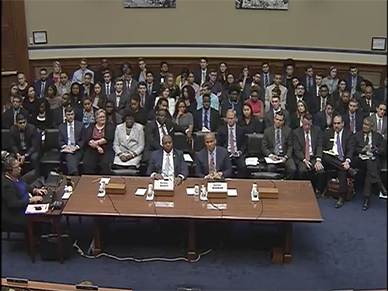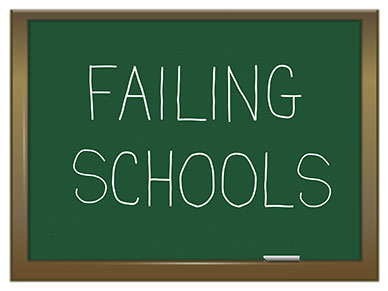
by gaopp | Jul 14, 2017
On June 28th, GCO’s Eric Cochling traveled to Washington, D.C. to be part of the Full House Committee on Oversight and Government Reform meeting, which took an in-depth look into “programs and legislation aimed at rehabilitating offenders, facilitating a successful transition from prison to community, and reducing recidivism.”
GCO provided a written testimony to our nation’s leaders but was also instrumental in providing the opportunity for William C. McGahan, Chairman of Georgia Works!, to testify before the committee. If you’re interested in hearing the committee’s conversation, you can view the meeting video online.


by Georgia Center for Opportunity | Jul 10, 2017
By: Randy Hicks and W. Bradford Wilcox
Although young men and women are taking what seems like a dizzying array of paths into adulthood these days, one path stands out as maximizing their shot at the American Dream: what scholars Ron Haskins and Isabel Sawhill have called the “success sequence.” The sequence is a three-pronged formula for success in America: graduate from high school, get a full-time job (or have a partner who does), and then marry before having children. Now, a joint report by the American Enterprise Institute (AEI) and the Institute for Family Studies (IFS) shows this “success sequence” works for Millennials as well.
Released last month, the report tracked how an astounding 97 percent of the oldest Millennials (ages 28-34) who follow this threefold success sequence avoid poverty. In contrast, 53 percent of young adults who didn’t follow the sequence at all are in poverty. Moreover, those who delayed childbearing until after marriage are more likely to not only survive financially, but thrive—finding themselves in the middle or upper third of income earners.
These data hold true regardless of family background, socioeconomic status, or race. Seventy-six percent of African Americans and 81 percent of Hispanic young adults who marry first are in the middle to upper third of income distribution, alongside 87 percent of whites. And 71 percent of Millennials who grew up in households in the bottom third of income distribution but put marriage before the baby carriage had the same economic fortune.
Here’s the message for Millennials—success in America is partly grounded on the three pillars of work, education, and family. But what about young people who struggled with one or more of these steps? Over half of Millennials have already become parents prior to marriage, many remain underemployed, and 53 percent of young adults who have not followed the sequence at all are in poverty.
Closer to home, Atlanta scored horrifically low for social mobility among low-income individuals, according to a joint Harvard and Berkeley study, even though middle-class job growth in Atlanta is strong. In our metro area, poverty rates remain unacceptably high, particularly for minority populations. Even though young adults in the metro Atlanta area are about equally likely to miss steps in the success sequence as their counterparts nationwide, young adults in the state of Georgia are more likely to miss at least one step in the success sequence, compared to young adults in the nation as a whole (46 percent versus 44 percent).
However, for both young and old, this new research isn’t justification for giving up on those who have missed one or more steps on the sequence. Instead, we need to understand that each part of the success sequence can work to help individuals; it’s never too late to get life back on track.
For children caught in multi-generational cycles of poverty, a good education can be a stick in the spokes of the poverty cycle that slows it down; for an adult, it’s a job; and for couples, it may be relationship enrichment programs and other supports. When all three parts of the success sequence work together, however, we begin to see significant results in boosting opportunity for the rising generation.
Many of these solutions must come locally. Mr. Hicks’ organization, the Georgia Center for Opportunity, has been spearheading numerous efforts to bring together local employers, community leaders, schools, churches, and nonprofits to advance vocational training and apprenticeships for workforce development, expand education options for the most vulnerable children, and promote marriage enrichment initiatives to help families flourish.
Here’s the bottom line: While no statistical model can predict an individual’s future success perfectly, we can know what’s more likely to happen. The AEI-IFS report points to what both common sense and experience have already told us: particular paths into adulthood are more likely to give individuals a shot at flourishing than others.
At the same time, it’s crucial to acknowledge that everyone who doesn’t follow the success sequence isn’t destined for failure or disaster. Neither does it suggest that every child born into better conditions is guaranteed success. All the success sequence tells us is what paths are most advantageous for human flourishing.
And it forces us to ask some serious questions: If we care about people, are we not duty-bound to communicate the message of the success sequence, and to do what we can to remove barriers to a quality education, fulfilling work, and a stable family life?
W. Bradford Wilcox is the director of the National Marriage Project at the University of Virginia and a coauthor of The Millennial Success Sequence.

by gaopp | Jun 29, 2017
GCO is seeking an experienced Communications Manager to manage and execute on our communications strategy and day-to-day communications needs in cooperation with other team members. We are especially interested in candidates who want to grow with the organization and demonstrate an ability to build and, ultimately, lead a communications team.
If you are interested, please visit our careers page and fill out the careers form.

by Georgia Center for Opportunity | May 25, 2017
Earlier this month New York Times columnist David Leonhardt joined the nationwide conversation with his article — “School Vouchers Aren’t Working, but Choice Is”—tackling the crucial issues of charter schools and vouchers in the broader school choice debate.
Mr. Leonhardt is right on point when he writes that charter schools “have the potential to help a lot of poor children in the immediate future.” Indeed, school-age kids have no time to spare when it comes to academics. Falling behind a few months in any grade can put them permanently behind.
Unfortunately, while we praise Mr. Leonhardt for acknowledging the many triumphs of charter schools, his analysis of the success of parental choice vouchers, which grant tax dollars to families to allow their children to attend private schools, falls short of the mark.
There are several glaring shortcomings with the study cited by Mr. Leonhardt. Conducted by the U.S. Department of Education, the study examined voucher use among public schools in the District of Columbia. Mr. Leonhardt uses the study’s findings to repeat a number of myths surrounding the question of parental choice vouchers.
First, Mr. Leonhardt praises random lottery selection for public charter schools and claims a major flaw in voucher programs is the ability of private schools to choose only the best students. But he fails to acknowledge that the voucher students examined in the Department of Education study received vouchers by winning a random lottery as well—the same way students get into public charter schools.
Secondly, the study only measured student performance after one year. Anytime a child shifts to a new education environment, the initial disruption frequently stunts test scores in the short term—partly due to a more rigorous curriculum and higher standards than the school they came from.
Students generally don’t switch schools unless there is a need, so those receiving vouchers or other forms of choice are usually already playing catch-up academically—and are doing so in a new school environment.
Along the same lines, the study compared apples to oranges by failing to track and evaluate these students before they switched to a new school via a voucher. Many students seek a different school environment—be it a public charter school or a private school through a voucher—because they aren’t learning well in their current environment.
Academic performance is best measured over a longer period of time. At a minimum, students should fully transition to a new school climate before measurements take place. In order to reach an accurate conclusion, a study would need to measure the same students before receiving a voucher and after—not just comparing to a control group that remained in public schools.
And finally, this point is crucial to remember: The D.C. voucher program is only one of many across the nation. So the research must be reviewed as a whole before declaring the whole idea of school choice vouchers a failure.
We commend Mr. Leonhardt for acknowledging the numerous successes of charter schools in helping students and families. And we applaud him for encouraging opponents of school choice “to look at the full evidence with an open mind.” But we also encourage Mr. Leonhardt to take his own advice by keeping an open mind on private-school choice through vouchers, even as he urges progressives to do the same with public charter schools.
All of us would do well to remember that education policy is not a zero-sum game. We need to stay focused on what kids need most—immediate access to a quality education.

by Georgia Center for Opportunity | May 16, 2017
America was founded on the principle that people should have the opportunity to flourish, to live out their dreams – to be happy. Our country’s forefathers cherished this important truth so much they included it in the United States’ Declaration of Independence. America was designed as a place where all citizens have “certain unalienable Rights, that among these are Life, Liberty and the pursuit of Happiness.”
While people search for satisfaction in life in various ways, employment continues to top the list as a measurement of happiness.
“In America, job satisfaction relates to life satisfaction. Among those who say they are very happy in their lives, 95 percent are also satisfied with their jobs,” writes Arthur Brooks, President of the American Enterprise Institute, in his book The Road to Freedom. “Only 5 percent say they are not satisfied with their work. The evidence also shows that the relationship is causal: job satisfaction actually increases life happiness.”
While not everyone has their dream job, working allows people to achieve something greater than themselves.
In the recently published book The Human Cost of Welfare, authors Phil Harvey and Lisa Conyers address the many reasons why work is so instrumental in fostering happiness. The book’s authors conclude that job achievement is needed for personal worth. Boredom and depression can result from lack of work, and being needed makes people feel valued and important. Depending on others for basic daily living needs decreases self-worth.
At Georgia Center for Opportunity, our goal is to help individuals flourish through productive work. More than half a million Georgians are without work, but desire the opportunity to succeed. Through extensive research and collaboration with community leaders, state lawmakers and businesses, we’ve been able to help improve work opportunities for ex-offenders. We’re also exploring practical options for real reforms to Georgia’s Welfare System, in hopes of motivating recipients to self-sufficiency.
Through collaboration with community partners, area nonprofits, local businesses, and community leaders, GCO has facilitated a series of “Hiring Well, Doing Good” discussions within the Atlanta area. These conversations give local business and organizations an opportunity to connect and share their best-practices for hiring unemployed or underemployed men and women while improving a company’s bottom line.
The evidence remains true even for part-time workers and those not receiving large paychecks. Brooks’ research shows that “[A]dults who worked ten hours a week or more in 2002, 89 percent said they were very satisfied or somewhat satisfied with their jobs. … There is no difference between those with below- and above-average incomes: 89 percent are satisfied.”
It’s quite clear that working is far more valuable than just the paycheck received at the end of the day.

by Georgia Center for Opportunity | May 4, 2017
“Children of today are the leaders of tomorrow and education is a very important weapon to prepare children for their future roles as leaders of the community.” – Nelson Mandela
The Georgia Department of Labor recently released a list of the state’s chronically failing public schools, which are schools that have received an F for three consecutive years on the College and Career Ready Performance Index.
More than 87,000 Georgia students are currently impacted by one of the 153 failing schools on the list. Failing schools equal failing students, and Georgia’s children deserve much better.
Georgia’s overall education data doesn’t provide much of a silver lining. Sixty-six percent of Georgia’s fourth graders are reading below proficiency, which means they cannot read at grade level. The data only gets more grim as grade levels increase – among eighth graders 70 percent are below proficiency in reading. In math, fourth graders are 65 percent below proficiency and eighth graders are 82 percent below proficiency.
A quality education is paramount to success as an adult. Research from the Brookings Institution shows that “those who finish high school, work full time, and marry before having children are virtually guaranteed a place in the middle class.” The report goes on to say that “only about two percent of this group ends up in poverty. Conversely, about three-fourths of those who have done none of these three things are poor in any given year.” Statistics like these also affect the future of our state and nation’s economy, as students today are in the military and workforce tomorrow.
Georgia Center for Opportunity recognizes this crisis and injustice to our students and continues to fight for expanded school choice options for students. Empowering parents with the opportunity to choose the high-quality education that best fits their children’s learning needs is the only way to get children away from failing schools immediately.
For more information about school choice options and educational savings account, which are currently being considered by the Georgia legislature, visit foropportunity.org/esa/.






